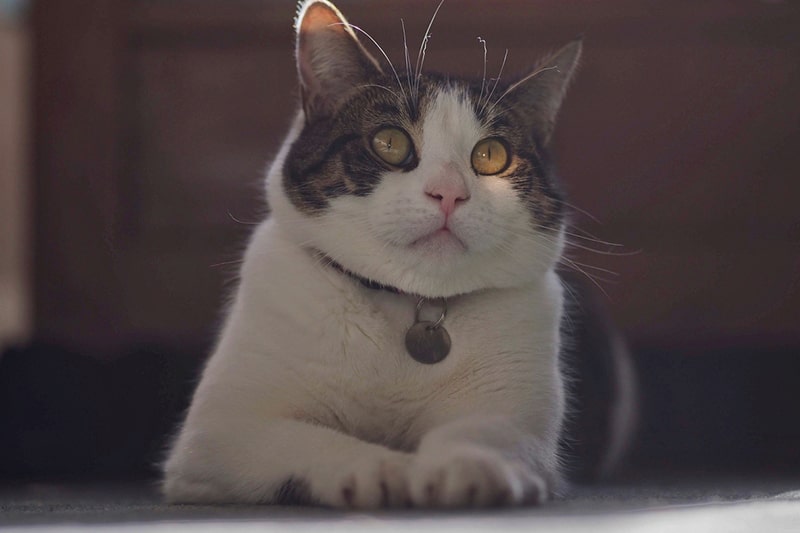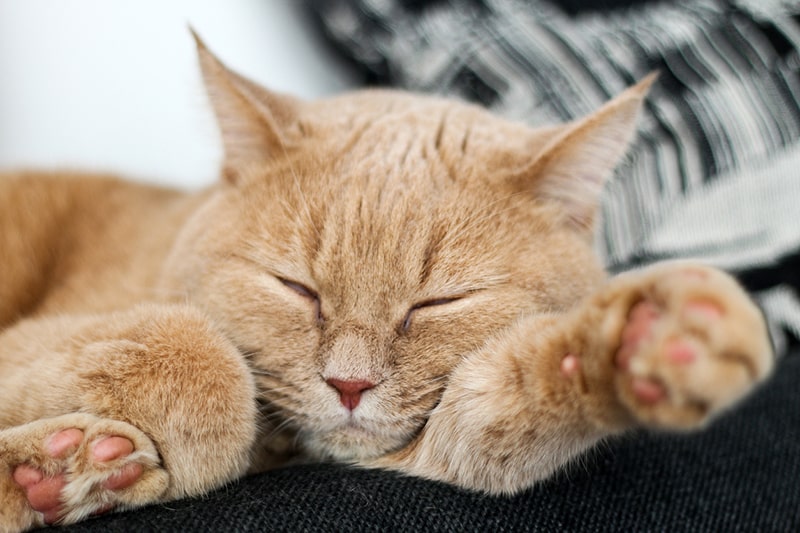Wrinkly Dog Care Tips
Wrinkly dogs require a little bit of extra cleaning and grooming. Check out some helpful tips on how to keep your dog’s wrinkles squeaky clean.
Mixed breed cats are beautiful, friendly, and unique felines that can make the perfect addition to a single person’s apartment or a large family’s home. These types of cats are far more common than many people may realize, so whether you know it or not, chances are you’ve probably already met one—or many.
Want to learn more mixed breed cat information? Then read on!
Throughout the years, mixed breed cats have been called by many names, including domestic cat, house cat, and moggie (a popular term used by people in the U.K.). What sets these cats apart from other cat breeds is that these cats aren’t actually a recognized breed. In other words, mixed cats do not have a pedigree, but they still have an interesting and rich history.
It is believed that cats were first domesticated in the Middle East, specifically around the time that humans began developing agriculture. Used to protect harvested crops and stored grains from rodents, cats proved to be so good at their job that many are still used for that same position even today.
Perhaps one of the other most well-known facts about the domestic cat’s history is that they have been around for a very, very long time. For instance, the practice of agriculture began around roughly 12,000 years ago (making cats just as old), and there is even a 9,000-year-old grave on the Mediterranean island of Cyprus, which has a cat buried with a human.
Many Egyptians also followed a similar practice. They believed cats to be sacred, so most were mummified and then buried with their human parents.
Over time, the domestic cat population eventually spread across the Middle East, Asia, Africa, and Europe. It wasn’t until European explorers began sailing to new lands that these cats were introduced to the Americas and Australia. During their voyages, the explorers always made sure to bring along their feline friends for rodent control—cats have proven time and time again that they excel at this job.

Moggie cats can be a mix between two purebred cats, a purebred and domestic cat, or two domestic cats. Due to this large variety in genetic options, moggies can appear in nearly any coat color or pattern, coat length, and body size. However, it is this large field of possibilities that makes so many people fall in love with these cats. Each mix is truly unique, and it’s always a little surprise to see what their personality becomes as they age.
Another wonderful advantage of having a mixed breed cat is that these cats tend to be highly intelligent. Oftentimes a result of getting the best of both genes from their parents, don’t be shocked if your moggie has some surprising skills.
Although moggie personalities can be just as varied as their looks, the general consensus from pet parents is that mixed cats make for wonderful companions. Their personalities, while unique to each cat, are loving and fun. Moggies tend to be fairly energetic and athletic, they meow on occasion, and almost all enjoy playing, cuddling, and spending time with their family.
Just as people enjoy finding out their ancestry, many pet parents are also curious to discover their cat’s breed history (and dogs for that matter). Chances are, when you adopt your mixed cat, the rescue or shelter you are adopting from will have an assumption as to the breeds in your cat’s history, but this is not always the case. If you are looking for a more definitive answer, you do have other options that you can explore.
One option is to be your own detective. Find and gather your clues and information, and with a little help from the internet, you will be able to come to your own conclusion. Figuring out your cat’s breed can be a fun and entertaining activity. First, you can examine your cat’s overall appearance and see if you initially notice any resemblance to other cat breeds you may know. Another way to go about classifying your cat is to look at many different physical characteristics and behavioral tendencies carefully.
For instance, it may be most helpful first to observe your cat’s coat length, color, and pattern. Other physical attributes to note are your cat’s eye color, the shape of their ears, nose, face, and body figure and size.
After you have documented these characteristics, you will then want to observe your cat’s mannerisms, vocal tendencies, and overall personality. Some questions to answer are, “Is my cat overly friendly or reserved?” “Does my cat always want to play, or is he/she a couch potato?” Once you find the answer to these questions, you will then be able to narrow down your searches on the internet significantly.
Purebred cats have much more specific characteristics and personalities (compared to moggies), which continue from one generation to the next. This should help alleviate many cat breeds from the get-go and hopefully make your search process much easier.
An alternative option for discovering your cat’s breed is to have a professional DNA test performed. Understanding that cat parents want to know their cat’s genetic makeup, many companies have created simple tests that can help clear up that mystery. Cat DNA tests work in a very similar fashion as human ancestry tests, in the sense that after selecting a company, you will receive a kit in the mail, you will swab your cat’s cheeks, and then you will send that information back to the company.
While the exact time can vary from organization to organization, most people receive their results back within two months. Besides revealing your cat’s genetic history, some of these tests can also show which country your cat’s ancestors were from, along with your cat’s health.
Another reason to love Moggies is that they don’t require any type of extensive grooming. A regular brushing will help keep your cat’s coat clean and healthy, in addition to decreasing hairballs. Your cat will also require a routine nail trimming and teeth brushing.
Even though every cat requires these grooming items, the frequency of each can vary from cat to cat, not to mention, depending on your cat’s hair length, you may need to use a specific type of brush or comb.

In the wide world of cats, mixed cats rank among some of the healthiest. Unlike defined cat breeds that often have specific health conditions that are reoccurring among generations, domestic cats oftentimes receive all the good genes from their parents. Just like any other type of cat, though, these felines are still susceptible to some health issues, so pet parents should not turn a blind eye to possible problems.
According to our claims data*, the top conditions that affect mixed cats are
Another common issue that can affect any cat is obesity. When they become overweight, cats are automatically at a higher risk of developing a long list of other health conditions. In order to keep your feline at a healthy weight, it’s important to provide them a nutritious diet and an appropriate amount of exercise.
If you ever find yourself unsure if your cat is at a healthy weight, simply schedule an appointment with your veterinarian to talk over your concerns. Veterinarians can offer great recommendations on how to keep your cat more active, and they can help you find what type of food and meal plan is best for your cat. Don’t forget—the type and amount of food your cat eats will change as they age.
Every year thousands of mixed cats end up in animal shelters and cat rescues, due to no fault of their own. Before you welcome a new feline into your home, consider first looking at your local organizations that adopt out rescued and displaced cats and kittens. You may be surprised at how much mixed breed cats can resemble purebred cats, and they make for just as wonderful companions.
When you adopt a moggie, it truly is like getting one happy surprise after the next. Not only can their coat patterns be unique, but most have their own individual personalities and traits as well. Let’s just say, the longer you have your moggie cat around, the more you will love and adore them.
If the time comes and you begin the search to find your new feline friend, don’t forget to consider the older crowd. Unfortunately, many people bypass senior cats for kittens, but these older and wiser cats don’t come without their perks. At an older age, cats will already be litter box trained, chances are they won’t have crazy bursts of energy or be jumping and knocking items off of counters, and they may already be used to a multi-animal household. And perhaps the best part about adopting an older cat is that they will want more cuddle and relaxing time.
Besides gaining a fabulous new member of the family, another benefit to adopting a mixed cat is that you help create the opportunity for other mixed cats to be adopted. When you adopt an animal, that spot then becomes open for another animal to be rescued and placed safely in the shelter, which will get them one step closer to finding their forever home.
If you are looking for other terrific ways to help moggies out, consider fostering one—or many! If you aren’t quite ready for a long-term commitment, but you still want to support your local rescues, then fostering may be the perfect option.
Of course, there are more fun facts to learn about this charming group of cats!
Whether you know them as mixed breed, mixed, domestic, or house cat, or even as moggies, these felines go by many names. Speaking of names, after you adopt your very own moggie, perhaps one of the next biggest decisions you will be making is deciding on a name. For a little bit of inspiration, check out the following list of names influenced by television shows.
While it can be helpful to have a small list of names already picked out before you adopt your cat or kitten, chances are once you see and begin playing with your new friend, deciding on a name will become a much easier decision than you may have realized.
*Internal Claims Data, 2019
The information presented in this article is for educational and informational purposes only and does not constitute or substitute for the advice of your veterinarian.